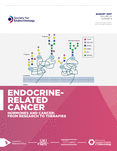Combination therapy approaches to target insulin-like growth factor receptor signaling in breast cancer
-
Figure 1
Schematic representation of therapeutic targeting of IGF1R expression and activity in breast cancer. Insulin-like growth factor receptor (IGF1R) signaling is mediated after the formation of homo- and heterodimers of IGF1R and the insulin receptor (InsR) in response to the binding of their respective ligands (i.e. IGF1 and IGF2 to IGF1R and insulin to InsR. In the cytoplasm, IGF1/IGF2 form a complex with insulin growth factor-binding proteins (IGFBPs) to reduce the pool of available ligand that can bind to IGF1R. IGF1R activation leads to downstream cell signaling of effector molecules that regulate PI3K/AKT, FAK and MAPK/MEK intracellular signaling pathways. SphK1 is phosphorylated and activated by ERK leading to both intracellular and extracellular activity of the bioactive lipid molecular sphingosine 1 phosphate (SIP) (Pitson et al. 2003, Granata et al. 2007). IGF1R can be activated after SIP1 and SIP3 receptor-mediated phosphorylation (Martin et al. 2009). Targeted therapies have been developed to inhibit IGF1R expression including IGF1R monoclonal antibodies (mAbs), IGF1/2 mAbs and IGF1R/InsR tyrosine kinase inhibitors. IGF1R-directed cancer therapies that inhibit IGF1R downstream effector molecules have also been developed including PI3K; AKT; mTOR; mRNA translation; FAK; MEK and SphK1. Novel combination therapies aimed at targeting IGF1R expression and activity are developing this area of breast cancer therapeutics. Reprinted by permission from the American Association for Cancer Research: Iams WT & Lovly CM, Molecular pathways: clinical applications and future direction of insulin-like growth factor-1 receptor pathway blockade, Clinical Cancer Research, 30 Sep 2015, volume 21 issue 19, pages 4270 to 4277, doi:10.1158/1078-0432.ccr-14-2518.
-
Figure 2
Prognostic significance of IGF1R and SphK1 co-expression in ER-positive and ER-negative breast cancers. Kaplan–Meier (KM) mRNA survival analysis was performed as follows in: (A) estrogen receptor (ER)-positive and (B) ER-negative, lymph node-negative breast cancers after the stratification for high IGF1R and SphK1 mRNA co-expression to determine disease-free survival (DFS) and overall survival (OS) probability (http://glados.ucd.ie/BreastMark/). (C) Table includes hazard ratio (HR) and log-rank P values for DFS and OS of IGF1R and SphK1 individual gene KM analysis.
- © 2016 Society for Endocrinology












